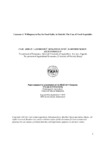Consumers’ Willingness to Pay for Food Safety in Nairobi: The Case of Fresh Vegetables
| dc.contributor.author | Lagerkvist, Carl Johan | |
| dc.contributor.author | Hess, Sebastian | |
| dc.contributor.author | Ngigi, Marther W | |
| dc.contributor.author | Okello, Julius Juma | |
| dc.date.accessioned | 2019-09-18T10:03:30Z | |
| dc.date.available | 2019-09-18T10:03:30Z | |
| dc.date.issued | 2011 | |
| dc.identifier.uri | http://ir.mksu.ac.ke/handle/123456780/4819 | |
| dc.description.abstract | Large urban areas in developing countries represent currently the most dynamically growing markets for food products. This study investigates the willingness to pay of consumers in Nairobi for safer leafy vegetables. We survey individuals’ perceived food safety across four major market categories, while also considering the explanatory role of trust and behavioral, psychological, and socio-demographic covariates. Results show that willingness to pay is market-specific and multi-faceted, with trust and perceived risks as important drivers, while income plays only a subordinate role. We conclude that policy makers should aim to reduce asymmetric information within the value chain without raising food prices such that safer vegetables would become unaffordable for the poor. | en_US |
| dc.language.iso | en_US | en_US |
| dc.subject | Food safety | en_US |
| dc.subject | Perceived risk | en_US |
| dc.subject | Willingness to pay | en_US |
| dc.subject | Regression tree | en_US |
| dc.subject | Urban agriculture | en_US |
| dc.title | Consumers’ Willingness to Pay for Food Safety in Nairobi: The Case of Fresh Vegetables | en_US |
| dc.type | Article | en_US |
Files in this item
This item appears in the following Collection(s)
-
School of Agricultural Sciences [118]
Sholary Articles by Faculty & Students in School of Agricultural Sciences

